machine
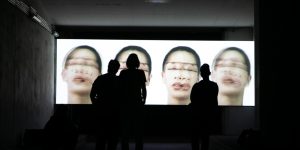
Modell 5
Granular Synthesis – Kurt Hentschlaeger (AT), Ulf Langheinrich (DE)
MODELL 5 is a performance or installation in which the face of Japanese performer Akemi Takeya is subject to drastic time-based interventions that create in essence a cyborg-like hybrid, between human and machine. A roller coaster dramaturgy following the “life” of the four clones on screens.
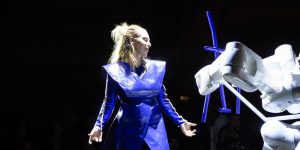
underbody
Silke Grabinger (AT)
This 15-minute performance follows on from last year's cooperation with Johannes Braumann and the Ars Electronica Futurelab. It is based on Gertrud Bodenwieser's play “Dämon Maschine” (1923), in which five dancers turned into one machine. Now, five machines play one dancer. Whereas in the original performance each person controlled a part of a machine, an industrial Kuka robot now controls a body part. Choreographer and dancer Silke Grabinger goes into a dance with this marionette.
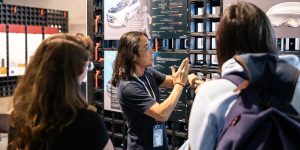
Infusing Empathy in Self Driving Cars Through Anime Expressions
Yuki Moriyama (JP), Eiji Kawata (JP), Ryohei Fukushi (JP)
In collaboration with Japanese animation studio Polygon Pictures, Mercedes-Benz has designed animations of different scenarios in which autonomous vehicles could build informed trust with humans. The basic idea when designing animes is that a lot of emotion is expressed in a few strokes. The key issue that this project concerns itself with is therefore: How can these basic principles be used for intuitive communication between human and machine?

Sentientia
Dorin Cucicov (MD)
Sentientia attempts to reconstruct the experience of a sentient creature that learns to interact with the external world. Inspired by Dr. Frankenstein’s creature, Sentientia sends audio signals to its environment and waits for a response to establish an emotional connection. Emotional combinations are generated by the machine and transformed into sound. Once the system understands that it has a mind and is conscious of its surroundings, will it start looking for entities like itself to create social networks of emotional intelligence?
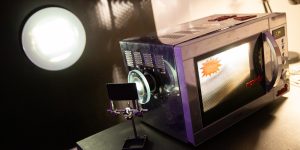
Insert & Play
Jeon Hess (KR)
*Insert & Play* is a microwave that functions as a moving image projector to provide a viable media player. While the project is a celebration of technology and industrial progress, it is also a reminder of nostalgic actions; insert and play—a ritual between man and machine on the verge of extinction.

Dreama
Anya Wang (CN)
This project does not attempt to control dreams but instead to bring this invisible machine to the physical world. It offers the audience an opportunity to think about a new way to describe dreams and the human obsession with control.

A reactive poetry machine
Fabian Frei (CH)
*A reactive poetry machine* is an experiment that examines the outcomes of trying to teach a machine poetry. Will it forever produce poetry in different variations of the same kind or will it succeed in crossing the threshold and creating something new? The interactive installation invites visitors to the Ars Electronica Festival to spend a moment away from the hustle and bustle of the festival to reflect on AI, poetry and their relationship.

Maschine, die auf Gott wartet
Hannes Waldschütz (DE)
The Maschine, die auf Gott wartet (“Machine that waits for God”) is part of a series of three “waiting machines.” They were activated in Bremen on October 24, 2007, at 6:07 p.m. From this point in time the three machines had been in operation, the Maschine, die auf Gott wartet is still waiting. It’s a microelectronic circuit, built and programmed in order to constantly inquire about the expected event: God must give a signal via a God sensor. An integrated backup power supply guarantees failure-free and uninterrupted functioning.
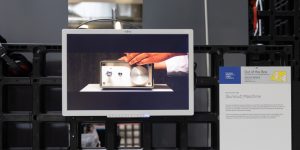
[burnout] Maschine
Max Kullmann (DE)
The [burnout] Maschine was designed to prevent individuals (who are part of an increasingly stressed society despite diminishing physical work) from burning out by taking on this exclusively human inadequacy. At the same time, the relationship between man and machine is questioned.
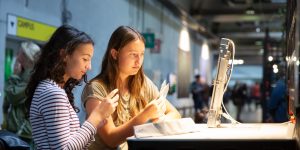
Privacy Machine
Timm Burkhardt (DE)
An electronic way to say, “I want to be private today and not appear in your social media photos.” Privacy Machine is a working proof of concept: stand in front of the screen and take the badge or the scarf. Both have a special pattern on it. As long as this pattern is recognized by the camera, the software will pixelate your face. It‘s an unrealistic wish because manufacturers would have to integrate this software into their smartphones as a default.


